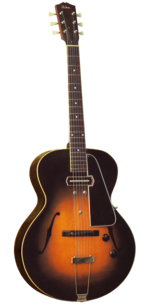This article needs additional citations for verification. (December 2009) |
| Gibson ES-150 | |
|---|---|
 Gibson ES 150 "Charlie Christian" | |
| Manufacturer | Gibson |
| Period | 1936–1940 (V1) 1940–1957 (V2) |
| Construction | |
| Body type | Hollow |
| Neck joint | Set |
| Scale | 24+3⁄4 inches (63 cm) |
| Woods | |
| Body | 16+1⁄4 inches (41 cm) wide, solid spruce archtop, solid maple back and sides |
| Neck | Mahogany |
| Fretboard | Rosewood with pearl dot inlays |
| Hardware | |
| Bridge | Ebony archtop-style bridge adjustable for height |
| Pickup(s) | One steel magnet blade-type single coil in the neck position (Charlie Christian pickup) |
| Colors available | |
| Sunburst | |
The Gibson ES-150 is a pioneering electric guitar produced by Gibson Guitar Corporation.[1] Introduced in 1936, it is generally recognized as the world's first commercially successful Spanish-style electric guitar. The ES stands for Electric Spanish, and Gibson designated it "150" because they priced it (in an instrument/amplifier/cable bundle) at around $150 (equivalent to $3,300 in 2023). The particular sound of the instrument came from a combination of the specific bar-style pickup and its placement, and the guitar's overall construction.
Unlike the usual acoustic guitars in jazz bands of the period, it was loud enough to take a more prominent position in ensembles. Upon its debut it immediately became popular with such notable guitar players as Charlie Christian, spreading its renown. Gibson produced the guitar with minor variations until 1940, when the ES-150 designation (the "V2") denoted a model with a different construction and pickup.
- ^ Hunter, Dave, The Rough Guide to Guitar, Penguin Books, 2011.